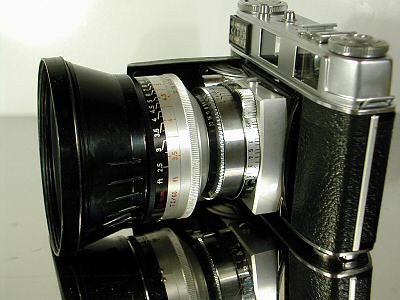Kodak Retina IB/IIC/IIIC
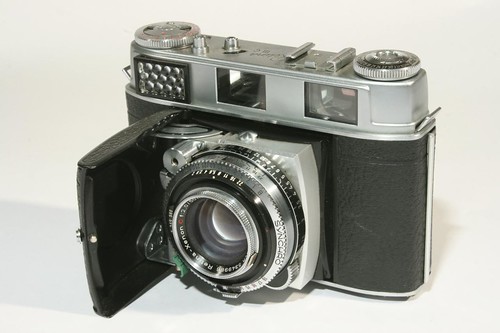
|
| Kodak Retina IIIC ("big C") image by Guy Sande (Image rights) |
In 1958 (actually November 1957 for Types 028 and 029), Kodak AG revised the Retina range with a new larger viewfinder that transformed the usability of the camera. The large bright-line finder incorporates outlines for the 80mm & 35mm lenses, and this obviates the need for a separate multiple finder.
Other than the deeper and more streamlined viewfinder housing, differences are minor. The exposure meter no longer has a flip-up lid giving a dual range, but neither did the last production of the IIIc. The leatherette has a slightly different, less "pebbled" look than in previous cameras, and the meter dial is simpler.
Towards the end of production (1961), sales of these cameras undoubtedly slumped, due in part to the arrival of the two rigid-bodied Retinas (the IIS & IIIS) both of of which undoubtedly look more modern. The IIIC is one of the few classic cameras not only to hold its price, but actually to increase it.
The three front-component lenses (80mm & two 35mm) also fit the Retina Reflex of the period. The same rules as to interchangeability apply with either camera (for a view of the lens mount differences, see below): only a camera with a Rodenstock mount can accept the Heligon front-lenses, and only one with a Schneider mount accepts the Xenon front-lenses. These 'front-component' lenses must not be confused with the new range introduced for the IIIS, which are complete lenses (i.e. there is no fixed rear component); these also fit the Retina Reflex S, III & IV.
The 80mm front-component accessory lens is not the most versatile of tools. Firstly it is large and dwarfs the camera. Secondly it is dreadfully slow in action. First, the focus distance must be measured with the rangefinder; a scale (around the lens) must then be consulted, which gives an adjusted value, which is finally set on the focus scale: see the picture below. The complete lenses on the IIIS are infinitely superior. The front-component lenses are less inconvenient on the Reflex camera, where the focus scale is not used. In addition, the Reflex is rigid-bodied; to fold the IIIC away after use, any accessory lens has first to be removed.
Contents
Specifications
Type 019 Model I Retina IB
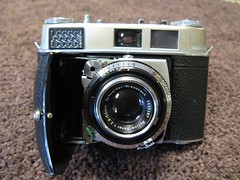
|
| Non-rangefinder Retina I B image by John Bosko (Image rights) |
- Production time: August 1957 to January 1958
- Serial number range: 460894 to 481599
- This model differs from the Type 018 Retina Ib by the addition of a single range exposure meter and a new-style top housing. The viewfinder remained the same size as the Type 019 Retina Ib.
- Fixed Lens: Schneider Retina-Xenar f/2,8 50mm
- Shutter: Synchro-Compur (Light Value) 1 sec - 1/500
- Level wind on base, with double exposure prevention
- Self-timer - X & M flash synchronization
- Viewfinder: bright-line, with parallax-correction marks
- Filter size 32mm
- Dimensions: width - 122mm; height - 85mm; depth - 90mm (open), 47mm (closed)
Type 019 Model II Retina IB
- Production time: January 1958 to 1960
- Serial number ranges: 481600 to 503638, 50001 to 83260
- This model differs from the Type 019 Model I Retina IB by a redesign of the top housing with a large viewfinder and an additional window for the bright-line projected frame. The first production models had an exposure meter range of ASA 5 to 1300. This was changed to an exposure meter range of ASA 10 to 3200 in late production.
Type 029 Retina IIC
- Production time: November 1957 to September 1958
- Serial number ranges: 759812 to 761445, 764556 to 767975, 50001 to 63509
- Lens: f/2.8 50mm Schneider Xenon C or f/2.8 50mm Rodenstock Heligon C (6 element)
- Interchangeable front component (bayonet)
- Alternative lenses: f/4 80mm, f/4 35mm, f/5.6 35mm
- Viewfinder: bright-line, with outlines for 35mm, 50mm & 80mm lenses, and parallax-correction marks
- Coupled rangefinder
- Dimensions: width - 122mm; height - 85mm; depth - 90mm (open), 47mm (closed)
- Price: £52.6.3 (1960)

|
| Retina IIIC meter cover for incident light readings image by Geoff Harrisson (Image rights) |
| ||
|
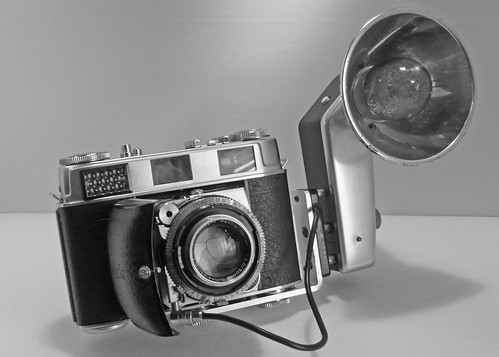
|
| Kodak Retina IIIC with Kodalite Super M 40 Flash holder and bracket image by PF McFarland (Image rights) |
Type 028 Retina IIIC
- Production Time: November 1957 to 1960
- Lens: f/2 50mm Xenon or f/2 50mm Heligon C (6 element)
- Interchangeable front component (bayonet)
- Alternative lenses: f/4 80mm, f/4 35mm, f/5.6 35mm
- Uncoupled exposure meter reading in Light Values (LV)
- Coupled rangefinder
- Viewfinder: bright-line, with outlines for 35mm, 50mm & 80mm lenses and parallax correction marks
- Dimensions: width - 122mm; height - 85mm; depth - 90mm (open), 47mm (closed)
- Price: £69.15.0 (1960)
Interchangeable lenses
- 80mm f/4 Longar-Xenon C or f/4 Heligon C - 60mm filter - Minimum focus 2m
- 35mm f/4 Curtar-Xenon C or f/4 Heligon C - 60mm filter - Minimum focus 0.8m
- 35mm f/5.6 Curtar-Xenon C or f/5.6 Heligon C - 32mm filter - Minimum focus 0.8m
Acccessories
- Stereo attachment
- Sports finder
- Close-up attachment
- Close-up rangefinder
- Ground-glass focusing adapter
- Micro attachment
- Kodalux L exposure meter
Notes for Collectors
The front and back components of the lens were matched. It is important that the number engraved on the front component is identical to the number on the adjacent mount.
The interchangeable front component lens was designed so that the Heligon & Xenon were not interchangeable. The mounting cam is in an entirely different position (see pictures).
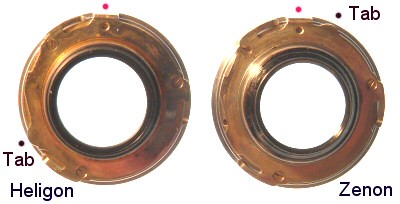
|
| Schneider-Kreuznach & Rodenstock mount differences image by paulfromukcamera (Image rights) |
Links
- Kodak Retina IB user manual album by Flickr user Gareth Wonfor
- Kodak Retina IIC and IIIC user manuals at Butkus.org
- Kodak Retina IB (small and large viewfinder, and Bedienungsanleitung PDF manual at www.OrphanCameras.com
- Camera Quest's critical review
Bibliography
- Retina Manual - Edward S Bomback - Fountain Press London 1956
- Retina Handbook - Edward S Bomback - Fountain Press London 1957
- The Retina Manual - O R Croy - Focal Press First Edition June 1952 - Tenth Edition April 1966
